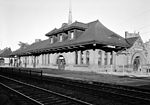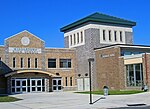Grace Episcopal Church (Middletown, New York)
19th-century Episcopal church buildingsChurches completed in 1868Churches in Orange County, New YorkChurches on the National Register of Historic Places in New York (state)Episcopal church buildings in New York (state) ... and 4 more
Gothic Revival architecture in New York (state)Hudson Valley, New York Registered Historic Place stubsNational Register of Historic Places in Orange County, New YorkNew York (state) church stubs

Grace Episcopal Church is a historic Episcopal church located at Middletown in Orange County, New York. The original church was built between 1846 and 1847, then enlarged and aggrandized in the Gothic Revival style between 1866 and 1868. A Collegiate Gothic style parish house was added in 1913. The church features an off-set bell tower with stepped buttresses and Gothic arched windows.It was listed on the National Register of Historic Places in 2010.
Excerpt from the Wikipedia article Grace Episcopal Church (Middletown, New York) (License: CC BY-SA 3.0, Authors, Images).Grace Episcopal Church (Middletown, New York)
North Street,
Geographical coordinates (GPS) Address Nearby Places Show on map
Geographical coordinates (GPS)
| Latitude | Longitude |
|---|---|
| N 41.446666666667 ° | E -74.419444444444 ° |
Address
North Street
North Street
10940
New York, United States
Open on Google Maps






